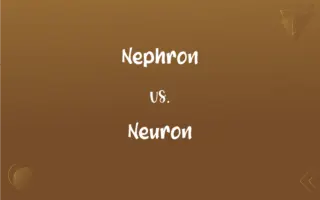Axon vs. Dendrite: What's the Difference?
Edited by Aimie Carlson || By Janet White || Published on January 24, 2024
Axons transmit electrical signals away from the neuron's cell body, while dendrites receive signals and direct them towards the cell body.

Key Differences
Axons are long, slender projections of a nerve cell that conduct electrical impulses away from the neuron's cell body. Dendrites, in contrast, are branched, tree-like structures that receive messages from other neurons and transmit these signals towards the neuron's cell body.
The primary function of an axon is to carry nerve impulses to other neurons, muscles, or glands. In contrast, dendrites specialize in receiving chemical signals from the synapses of other neurons and converting them into electrical impulses.
In terms of structure, axons are typically longer and have fewer branches compared to dendrites, which have complex arborizations to maximize contact with other neurons.
The axon often has a myelin sheath, enhancing signal speed and efficiency, while dendrites lack this feature, focusing on signal reception rather than rapid transmission.
Axons end in terminal buttons that release neurotransmitters, whereas dendrites contain receptors that bind to these neurotransmitters, facilitating inter-neuronal communication.
ADVERTISEMENT
Comparison Chart
Function
Transmits signals away from cell body
Receives signals towards the cell body
Length
Generally longer
Shorter, more branched
Branching
Less branched
Highly branched
Myelination
Often myelinated
Not myelinated
Connection
Connects to other cells' dendrites
Receives from other cells' axons
ADVERTISEMENT
Axon and Dendrite Definitions
Axon
Axons function as the primary transmission lines of the nervous system.
The rapid response was due to the efficient transmission along the axon.
Dendrite
Dendrites contain receptors for neurotransmitter binding.
The dendrite's receptors were key in synaptic communication.
Axon
Axons vary in length, from microscopic to spanning the body.
The motor neuron had a long axon reaching from the spinal cord to the muscle.
Dendrite
Dendrites increase a neuron's receptive surface area.
The neuron's dendrites branched extensively to interact with multiple neurons.
Axon
An axon is a neuron's elongated fiber that transmits impulses to other cells.
The neuron's axon extended to form connections with neighboring cells.
Dendrite
Dendrites act as the antennae of the neuron, sensing chemical signals.
Neurotransmitters bound to the dendrite's receptors, triggering a response.
Axon
An axon can be myelinated for faster signal transmission.
Myelination along the axon greatly increased the speed of nerve impulses.
Dendrite
Dendrites contribute to the integration of synaptic inputs.
The dendrites integrated signals from various neurons to form a coherent response.
Axon
Axons terminate in synapses, releasing neurotransmitters.
The axon's terminal released neurotransmitters to communicate with another neuron.
Dendrite
Dendrites are branched extensions of a neuron that receive electrical signals.
The dendrites buzzed with activity as they received incoming signals.
Axon
The usually long process of a nerve fiber that generally conducts impulses away from the body of the nerve cell.
Dendrite
A mineral crystallizing in another mineral in the form of a branching or treelike mark.
Axon
(cytology) A nerve fibre which is a long slender projection of a nerve cell, and which conducts nerve impulses away from the body of the cell to a synapse.
Dendrite
A rock or mineral bearing such a mark or marks.
Axon
Long nerve fiber that conducts away from the cell body of the neuron
Dendrite
A branched protoplasmic extension of a nerve cell that conducts impulses from adjacent cells inward toward the cell body. A single nerve may possess many dendrites. Also called dendron.
Dendrite
(cytology) A slender projection of a nerve cell which conducts nerve impulses from a synapse to the body of the cell; a dendron.
Dendrite
(cytology) Slender cell process emanating from the cell bodies of dendritic cells and follicular dendritic cells of the immune system.
Dendrite
Tree-like structure of crystals growing as material crystallizes
Dendrite
A hermit who lived in a tree
Dendrite
A stone or mineral on or in which are branching figures resembling shrubs or trees, produced by a foreign mineral, usually an oxide of manganese, as in the moss agate; also, a crystallized mineral having an arborescent form, e. g., gold or silver; an arborization.
Dendrite
Short fiber that conducts toward the cell body of the neuron
FAQs
Are axons myelinated?
Many axons are myelinated to increase impulse speed.
Do dendrites have myelin?
No, dendrites are not typically myelinated.
What is a dendrite?
A branched extension of a neuron that receives electrical signals.
Can axons regenerate after damage?
Axon regeneration is limited, especially in the central nervous system.
How do axons and dendrites differ in function?
Axons transmit signals away from the neuron, dendrites receive signals.
What are axon terminals?
The endings of axons where they form synapses and release neurotransmitters.
What's the difference in length between axons and dendrites?
Axons can be very long, while dendrites are comparatively shorter.
What is the main role of axons in the nervous system?
To carry nerve impulses to other neurons or effector cells.
How do dendrites contribute to neural processing?
They receive and integrate synaptic inputs.
Are all axons similar in diameter?
Axon diameters vary, influencing the speed of impulse transmission.
What is an axon?
A long projection of a neuron that transmits electrical impulses away from the cell body.
Do dendrites change over time?
Yes, dendritic structures can change with learning and neural activity.
How do dendrites affect a neuron's connectivity?
More branched dendrites increase connections with other neurons.
Can dendrites form synapses?
Yes, dendrites form synapses with axons of other neurons.
How do axons and dendrites interact in a neural circuit?
Axons transmit signals to dendrites, facilitating neural communication.
Are axon and dendrite lengths fixed?
They can vary and change based on neuron type and neural activity.
Do dendrites only receive excitatory signals?
No, dendrites can receive both excitatory and inhibitory signals.
How does myelination affect axon function?
It speeds up electrical conduction along the axon.
What is axonal transport?
The movement of substances within the axon.
Do dendrites have a role in memory?
Yes, dendritic structure and function are important in memory formation.
About Author
Written by
Janet WhiteJanet White has been an esteemed writer and blogger for Difference Wiki. Holding a Master's degree in Science and Medical Journalism from the prestigious Boston University, she has consistently demonstrated her expertise and passion for her field. When she's not immersed in her work, Janet relishes her time exercising, delving into a good book, and cherishing moments with friends and family.
Edited by
Aimie CarlsonAimie Carlson, holding a master's degree in English literature, is a fervent English language enthusiast. She lends her writing talents to Difference Wiki, a prominent website that specializes in comparisons, offering readers insightful analyses that both captivate and inform.































































